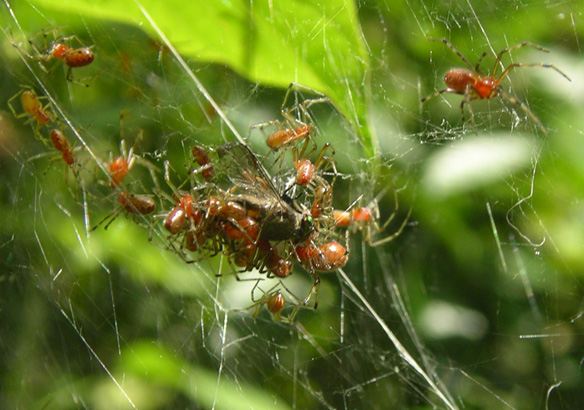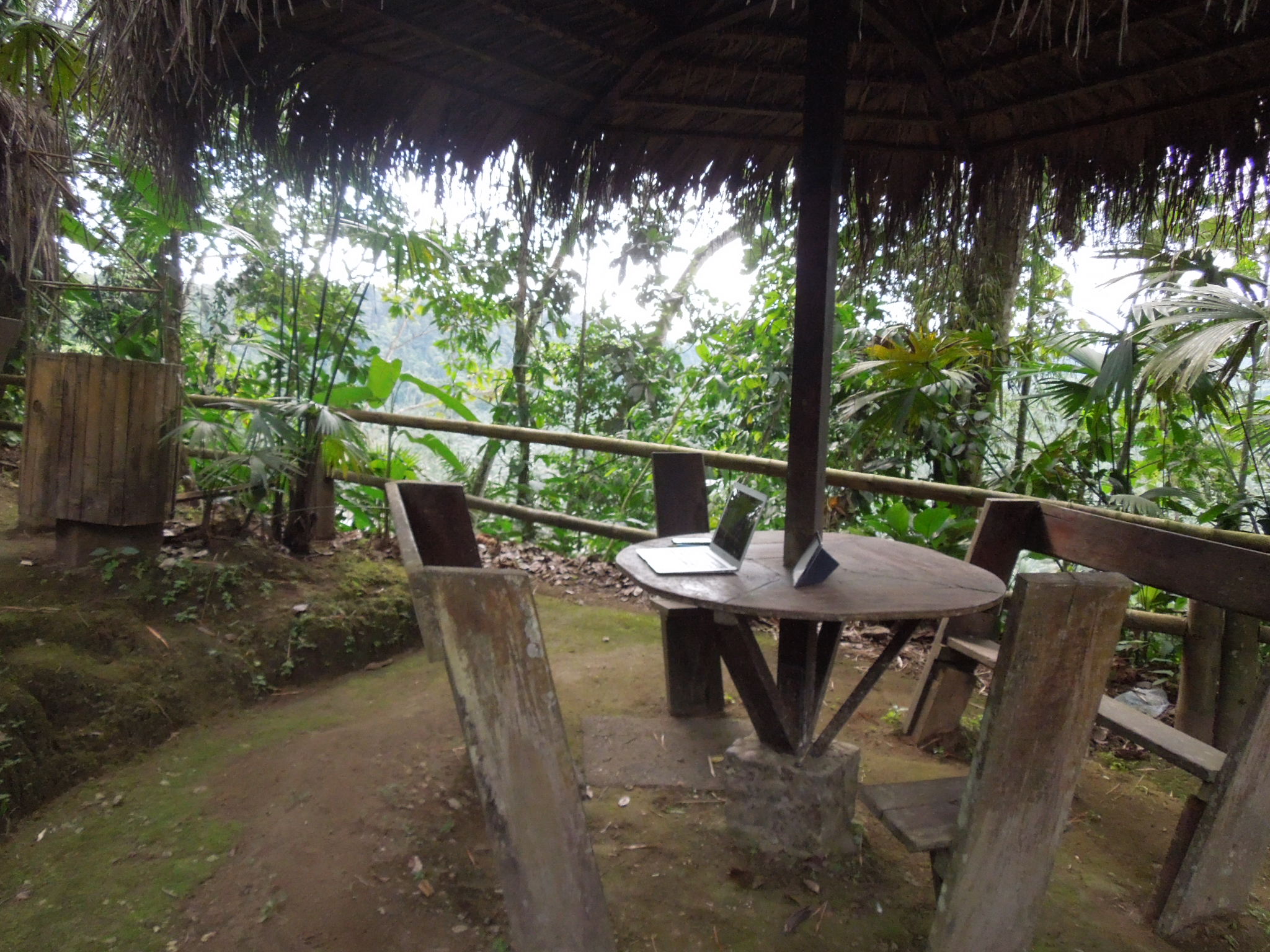Social spiders have been the inspiration for most of my scientific work since I was an undergraduate in Ecuador close to four decades ago. As they presented me with one puzzle after another, they led me in a journey of discovery through the fields of ecology, evolution, and behaviour. It is thus with a heavy heart that I have watched the tragedy of the irregularities of Jonathan Pruitt’s data on social spiders unfold [link; and here]. I worry about what this means for our areas of inquiry; for the people, in particular the young scientists whose careers are being affected; and for the public’s and the scientific community’s perception of these extraordinary organisms. But, just as in the study of animal personality Pruitt’s work constitutes only a small part, personality studies have been only a relatively recent addition to social spider research and Pruitt’s not the only work in this area.

Communal prey capture in a social spider. Photo L. Aviles, Cuyabeno, Ecuador 2003, all rights reserved.
For close to four decades, I have had the privilege to bear witness to the remarkable biology of these organisms. Social spiders, in particular those found in the tropics forming isolated colony lineages with highly female biased sex ratios, are striking for the ways they illustrate, with unprecedented clarity, how biased sex ratios, permanent systems of inbreeding, group living and sociality evolve. Their replicated origins on different continents, from genera where related less-social species exist, allow us to appreciate how intrinsic organismal features interact with external environmental factors to yield social and non-social species in different settings. The ease with which we can watch their colonies disperse or go extinct further allows us to study how local dynamical instability can be maintained within a globally stable metapopulation system.
Indeed, it is the combination of a dynamic colony birth-dispersal-extinction process, in the context of strong population subdivision, that makes the inbred social spiders the quintessential example of the population structure Maynard Smith and others envisioned back in the 1960s and 70s would be required for group-level selection to take place. The temperate species that Pruitt studied exhibits a different population structure, as its colonies are typically single-family units from which the majority of individuals disperse to find mates outside their nests. In some areas of its range, however, this species exhibits partial dispersal, with some individuals possibly mating with close relatives within their natal groups. Such an intermediate population structure makes this, along with its inbred more social relatives, and similar species in other genera, remarkable systems for studying the rules of multilevel selection.
More recently, social spiders have also emerged as potential models in community ecology. The occurrence in some areas of multiple species with different social systems illustrates how group living and cooperation may play a role in resource partitioning and community assembly. Likewise, the plethora of inquilines and parasites associated with their nests and colonies makes social spiders remarkable metacommunity systems and, given their behavioural responses to their inquilines, potential examples of social immunity. Research on all these areas, from sex ratios and multilevel selection to social immunity, is, and should be, ongoing, as the almost half-century of research on these remarkable organisms has done little to drain the well of questions and opportunities for further inquiry.
Personality is a relatively recent arrival to research on social spiders. It is also not my area of research, partly because my focus has been on traits, such as sex ratios, colony size, dispersal and extinction, likely to yield large and thus, in my view, more readily detectable effects. But, I was happy to facilitate Jonathan’s work in Ecuador, introducing him to the systems I had become familiar with over the decades. My students and I know from experience that social spiders can yield impressive answers, but the process requires painstaking dedication, time, and, at times, large research teams. I was thus a bit surprised by the rate at which Pruitt’s publications appeared, but, who was I to say about data capture rates in a subfield that was far from my expertise? I am thus thankful for the courageous people who called attention to the potential problems with Pruitt’s data so that we, including myself, have the opportunity to set the scientific record straight. Science may be a career for some, but for most of us it is also a calling, a calling to uncover the beauty that lies hidden in the remarkable biology of organisms, such as the social spiders, that are whispering their secrets to those humble enough to pay attention and listen. And listen we must, because they know better than any of us ever could.
—————————————————–
Here are some references relevant to the various areas of social spider research:
General reviews:
Avilés, L. (1997). Causes and consequences of cooperation and permanent-sociality in spiders. In J. Choe & B. Crespi (eds.), The evolution of social behavior in insects and Arachnids (pp. 476–498). Cambridge: Cambridge University Press.
Lubin, Y., & Bilde, T. (2007). The evolution of sociality in spiders. Advances in the Study of Behavior 37: 83–145.
Avilés, L., & Guevara, J. (2017). Sociality in spiders. In D. R. Rubenstein & P. Abbot (Eds.), Comparative social evolution (pp. 188–223). Cambridge, MA: Cambridge University Press.
Avilés, L. (2020) Social Spiders. In Starr, C. (ed.) Encyclopedia of Social Insects. Springer, Cham (upcoming).
On sex ratios and multilevel selection:
Avilés, L. (1993). Interdemic selection and the sex- ratio – A social spider perspective. American Naturalist 142: 320–345.
Smith, D. R. & Hagen, R. H. (1996) Population structure and interdemic selection in the cooperative spider Anelosimus eximius. Journal of Evolutionary Biology 9: 589–608.
Vanthournout, B., Busck, M. M., Bechsgaard, J., Hendrickx, F., Schramm, A., & Bilde, T. (2018). Male spiders control offspring sex ratio through greater production of female-determining sperm. Proceedings B 285: 20172887.
On inbreeding and its consequences:
Agnarsson, I., Avilés, L., Coddington, J. A., & Maddison, W. P. (2006). Sociality in theridiid spiders – Repeated origins of an evolutionary dead end. Evolution 60: 2342–2351.
Avilés, L., & Purcell, J. (2012). The evolution of inbred social systems in spiders and other organisms: from short-term gains to long term evolutionary dead-ends? Advances in the Study of Behavior 44: 99–133.
Settepani, V., Schou, M.F., Greve, M., Grinsted, L., Bechsgaard, J., & Bilde, T. 2016. Evolution of sociality in spiders leads to depleted genomic diversity at both population and species levels. Molecular Ecology 26: 4197–4210.
On the ecology of social evolution:
Riechert, S. E. & Jones, T. C. (2008) Phenotypic variation in the social behaviour of the spider Anelosimus studiosus along a latitudinal gradient. Animal Behaviour 75: 1893–1902.
Yip, E. C., Powers, K. S., & Avilés, L. (2008). Cooperative capture of large prey solves scaling challenge faced by spider societies. Proceedings of the National Academy of Sciences USA 105: 11818–11822.
Majer, M., Svenning, J. C., & Bilde, T. (2013) Habitat productivity constrains the distribution of social spiders across continents: Case study of the genus Stegodyphus. Frontiers in Zoology 10: 9.
Guevara, J., & Avilés, L. (2015). Ecological predictors of spider sociality in the Americas. Global Ecology and Biogeography 24: 1181–1191.
Hoffman, C. R. & Avilés, L. (2017). Rain, predators, and spider sociality: a manipulative experiment. Behavioral Ecology 28: 589-596.
On dispersal, extinction, and unstable colony population dynamics:
Crouch, T., & Lubin, Y. (2001). Population stability and extinction in a social spider Stegodyphus mimosarum (Araneae: Eresidae). Biological Journal of the Linnean Society 72: 409–417.
Avilés, L., Maddison, W., & Agnarsson, I. (2006) A new independently derived social spider with explosive colony proliferation and a female size dimorphism. Biotropica 38: 743–753.
Berger-Tal, R., Berner-Aharon, N., Aharon, S., Cristina Tuni, C., & Lubin, Y. (2016). Good reasons to leave home: proximate dispersal cues in a social spider. Journal of Animal Ecology 85: 1035–1042.
Gonzaga, M. O. and Vasconcellos-Neto, J. (2001) Female body size, fecundity parameters and foundation of new colonies in Anelosimus jabaquara (Araneae, Theridiidae). Insectes Sociaux 48: 94–100.
Sharpe, R.V. and L. Avilés. (2016). Prey size and scramble vs. contest competition in a social spider: implications for population dynamics. Journal of Animal Ecology 85:1401-1410.
On social spiders in ecological communities and as metacommunities with possible social immunity:
Agnarsson, I., Gotelli, N. J., Agostini, D., & Kuntner, M. (2015) Limited role of character displacement in the coexistence of congeneric Anelosimus spiders in a Madagascan montane forest. Ecography 39: 743-753.
Fernandez-Fournier, P., Guevara, J., Hoffman, C., & Avilés, L. (2018). Trait overdispersion and the role of sociality in the assembly of social spider communities across the Americas. Proceedings of the National Sciences USA 115: 610–615.
Fernandez-Fournier, P. & Avilés, L. 2018. Environmental filtering and dispersal as drivers of metacommunity composition: Complex spider webs as habitat patches. Ecosphere 9(2), e02101.
Straus, S. & Avilés, L. (2018). Effects of host colony size and hygiene behaviors on social spider kleptoparasite loads along an elevation gradient. Functional Ecology 32: 2707-2716.
Keiser, C.N., Hammer, T.J., Pruitt, J.N. (2019) Social spider webs harbour largely consistent bacterial communities across broad spatial scales. Biology Letters 15: 20190436.
On individual differences and task specialization:
Rypstra, A. L. (1993) Prey size, social competition, and the development of reproductive division-of-labor in social spider groups. American Naturalist 142: 868–880.
Ebert, D. (1998) Behavioral asymmetry in relation to body weight and hunger in the tropical social spider Anelosimus eximius (Araneae, Theridiidae). Journal of Arachnology 26: 70–80.
Settepani, V., Grinsted, L., Granfeldt, J., Jensen, J. L., & Bilde, T. (2013). Task specialization in two social spiders, Stegodyphus sarasinorum (Eresidae) and Anelosimus eximius (Theridiidae). Journal of Evolutionary Biology 26: 51–62.
Beleyur, T, Bellur, D.U., & Somanathan, H. (2015). Long-term behavioural consistency in prey capture but not in web maintenance in a social spider. Behavioral Ecology and Sociobiology 69: 1019–1028.
Junghanns, A., Holm, C., Schou, M.F., Sorensen, A.B., Uhl, G., & Bilde, T. (2017). Extreme allomaternal care and unequal task participation by unmated females in a cooperatively breeding spider. Animal behaviour 132: 101-107.
And so much more…..
by Leticia Avilés, University of British Columbia, Vancouver, Canada (laviles.ubczool@gmail.com), 8 Feb 2020
 Follow
Follow A place to share the joy of chipping away at the mysteries of nature….and the joy of teaching and sharing this excitement with others.
A place to share the joy of chipping away at the mysteries of nature….and the joy of teaching and sharing this excitement with others.